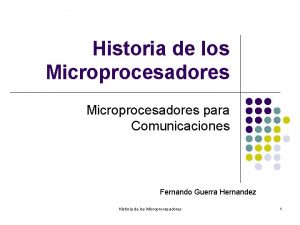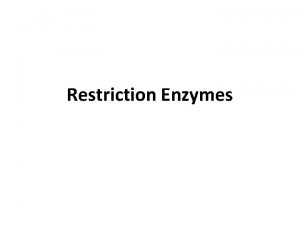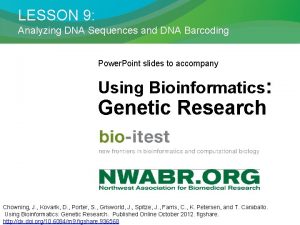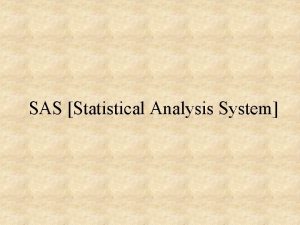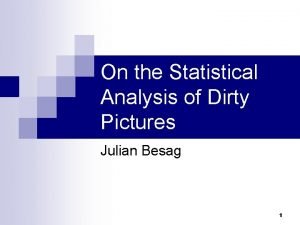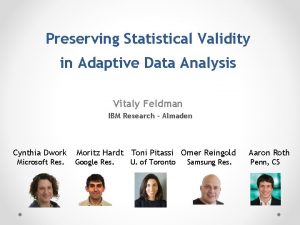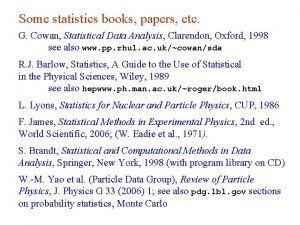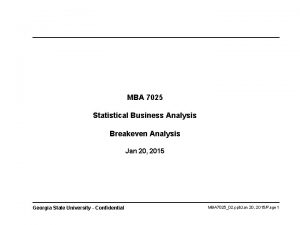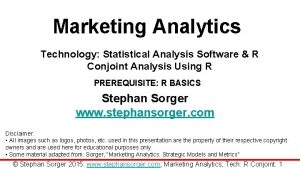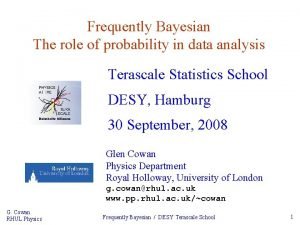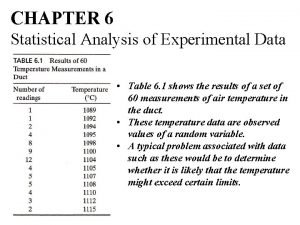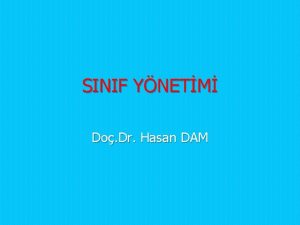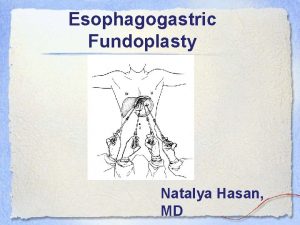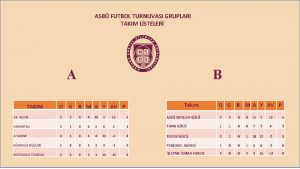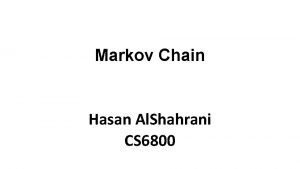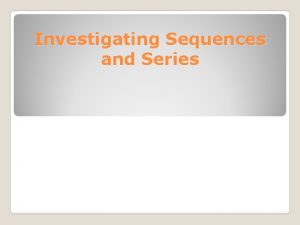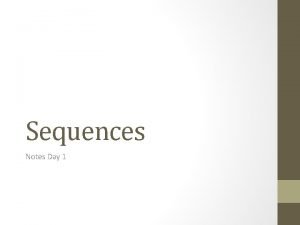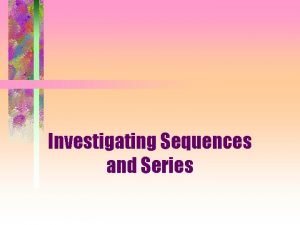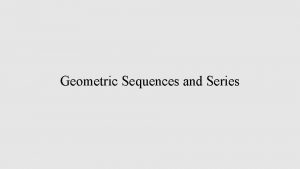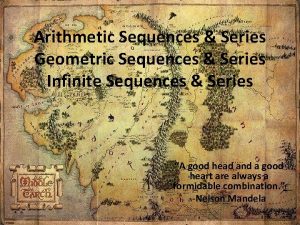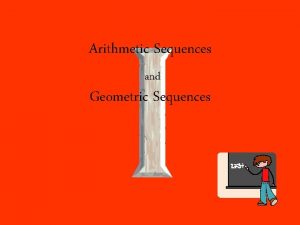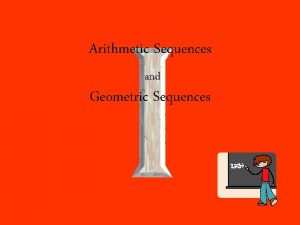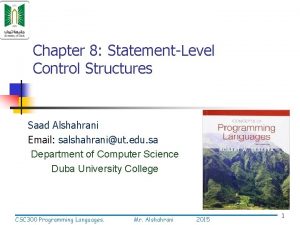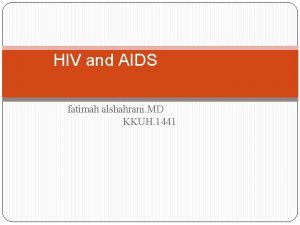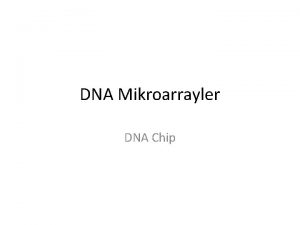DNA Sequences Analysis Hasan Alshahrani CS 6800 Statistical


























- Slides: 26

DNA Sequences Analysis Hasan Alshahrani CS 6800 • Statistical Background : HMMs. • What is DNA Sequence. • How to get DNA Sequence. • DNA Sequence formats. • Analysis methods and tools. • What is next ?

HMMs Hidden Markov Model (HMM) is very useful statistical model for molecular biology although it was aimed to be used for speech recognition purposes. HMM can be used as a statistical profile for a protein family (DNAs) and hence used to search a database for other similarities or family members. Q 1 : How can HMMs be used in DNA analysis?

To calculate the probability of the sequence ACTTCG, we multiply the probabilities; where the probability is the conditional probability that a certain nucleotide appears in a position, given that a specific nucleotide was in the previous position: P (ACTTCG…. ) = P 1(A) * P 2(C|A) * P 3(T|C) * P 4(T|T) * P 5(C|T) * P 6(G|C)…………

In more formal way , HMM cannot be observed directly but we can infer the hidden state qt from a random observation Yt

What is DNA sequence ? • DNA consists of two long interwoven strands that form the famous “double helix”. Each Strand is built from a small set of molecules called nucleotides. • Often the length of double-stranded DNA is expressed in the units of basepairs (bp), kilobasepairs (kb), or megabasepairs (Mb), so that this size could be expressed equivalently as 5 X 10 ^6 bp, 5000 kb, or 5 Mb • Collectively, the 46 chromosomes in one human cell consist of approximately 3 X 10^9 bp of DNA


How to get DNA sequence • By using chemical methods for determining the order of the nucleotide bases: Adenine, Guanine, Cytosine, and Thymine - in a molecule of DNA • Used in many fields and applications such as Forensics and biological systems • why don’t we use the powerful text searching algorithms and tools to search DNA databases?

DNA can be sequenced by a chemical procedure that breaks a terminally labelled DNA molecule partially at each repetition of a base. DNA Sequencing can be done by different methods : 1. Maxam-Gilbert sequencing 2. Chain-termination methods 3. Dye-terminator sequencing 4. Automation and sample preparation 5. Large scale sequencing strategies Q 2: Name four of DNA Sequencing methods

Example : a chain termination method A DNA sequencing printout. The sequence is represented by a series of peaks, one for each nucleotide position. In this example, a red peak is an A, blue is a C, orange is a G, and green is a T.

DNA Sequence formats: • Plain sequence format • EMBL format • FASTA format • GCG-RSF (rich sequence format) • Gen. Bank format • IG format

FASAT Format : • FASTA format is the standard format in the field of bioinformatics to represent either nucleotide sequences or peptide sequences. • This format is single-letter code and it allows sequence names and comments • FASAT consists of a single-line description at the beginning followed by sequence data in multiple lines. • The length of the each chunk (line) of the sequence must not exceeds 80 characters. • Sequence identifiers are defined by a standard called NCBI Q 3: what is FASAT format?

NCBI Data Base: • National Centre for Biotechnology Information (www. ncbi. nlm. nih. gov) is sequence database in US maintain a huge collection of DNA and protein sequences. • Each sequence in NCBI is stored in a separate record with a unique identifier called accession. • Example : By accessing the NCBI website and using this accessing NC_001477, we can retrieve the DNA sequence for Dengue virus that causes Dengue fever

NCBI cont…. . The database query can be done either directly from the website or by using the R functions choosebank() and query()

Analysis methods The analysis fall into 5 main methods : • Knowledge-based single sequence analysis. • Pairwise sequence comparison. • Multiple sequence alignment. • Sequence motif discovery in multiple alignments. • Phylogenetic inference. Q 4: What are the main methods of DNA sequence analysis ?

Analysis methods: alignment • Alignment: to compare a sequence with sequences that have already been reported and stored in a database. • Alignment can be global and local • Local alignments: reveal regions that are highly similar, but do not necessarily provide a comparison across the entire two sequences. • The global approach compares one whole sequence with other entire sequences.

Alignment Examples:

Alignment Tools : BLAST • The most common local alignment tool is BLAST (Basic Local Alignment Search Tool) developed by Altschul et al. (1990. J Mol Biol 215: 403) “BLAST is a set of algorithms that attempt to find a short fragment of a query sequence that aligns perfectly with a fragment of a subject sequence found in a database. ” • That initial alignment must be greater than a neighborhood score threshold (T) , the fragment is then used as a seed to extend the alignment in both directions… Which means BLAST algorithm breaks the query into short words of a specific length

Joshua Naranjo Q 5: what is BLAST algorithm ? State its steps.

Can R Help ? • Yes. • It has so many useful packages to process DNA Sequences. • It can be used to access BLAST as well.

Examples : DNA sequence Composition 1. GC fraction: GC content is one of the fundamentals properties of a genome sequence, which is the percentage of Gs and Cs ((GC)s). We can do that by two ways: • lengthy one is to use the statistics to calculate the percentage of GC with respect to the whole string. • The other way is to use function GC () from the R package Seqin. R, and we will go with this option as shown below

2. DNA words: It the same idea of knowing the frequency of some nucleotides such as A or G but with longer words like “AA” or “CA”. Those can be 2 nucleotides such as “GC”, 3 nucleotides like “AAA” or 4 nucleotides long and so on. An example of 3 nucleotides words is shown below:

3. To find the score for the optimal global alignment between the sequences ‘GAATTC’ and ‘GATTA’, we type:

4. Comparing two sequences using a dotplot()

Is it that easy ? No • It is not simply give the sequences to R and get the results. • It is an art which need a degree of skills. • Fitting the sequences to be compared to a form that reflects some shared quality. For example: -How they look structurally, -How they evolved from a common ancestor, or -Optimization of a mathematical construct

What is next ? Are we monkeys ?

References: 1. 2. 3. 4. 5. 6. 7. 8. http: //www. garlandscience. com/res/pdf/9780815365099_ch 02. pdf http: //library. umac. mo/ebooks/b 28050393. pdf https: //courses. cs. washington. edu/courses/cse 527/00 wi/lectures/roottr. pdf http: //www. lancaster. ac. uk/pg/nemeth/Hidden%20 Markov%20 Models%20 with%20 Applications%20 to%20 D NA%20 Sequence%20 Analysis. pdf https: //www. ndsu. edu/pubweb/~mcclean/plsc 411/Blast-explanation-lecture-and-overhead. pdf http: //www. cs. ru. ac. za/research/g 07 V 3343/deliverables%5 CShort%20 Paper%5 CSpecies%20 Identification%2 0 through%20 DNA%20 String%20 Analysis%20 -%20 Summary. pdf http: //a-little-book-of-r-for-bioinformatics. readthedocs. org/en/latest/src/chapter 4. html https: //www. bioconductor. org/packages/3. 3/bioc/vignettes/DECIPHER/inst/doc/Art. Of. Alignment. In. R. pdf
 Microprocesador motorola 6800
Microprocesador motorola 6800 Saad alshahrani
Saad alshahrani Restriction enzymes
Restriction enzymes Dna sequences
Dna sequences Replication fork
Replication fork Bioflix activity dna replication lagging strand synthesis
Bioflix activity dna replication lagging strand synthesis Coding dna and non coding dna
Coding dna and non coding dna What role does dna polymerase play in copying dna?
What role does dna polymerase play in copying dna? Dna rna protein synthesis homework #2 dna replication
Dna rna protein synthesis homework #2 dna replication Statistical analysis system
Statistical analysis system On the statistical analysis of dirty pictures
On the statistical analysis of dirty pictures Preserving statistical validity in adaptive data analysis
Preserving statistical validity in adaptive data analysis Multivariate statistical analysis
Multivariate statistical analysis Cowan statistical data analysis pdf
Cowan statistical data analysis pdf Statistical business analysis
Statistical business analysis Amce conjoint
Amce conjoint State bayes theorem
State bayes theorem Statistical analysis of experimental data
Statistical analysis of experimental data Hasan dam
Hasan dam Ece melis adalet
Ece melis adalet Jude hasan
Jude hasan Zahid hasan diu
Zahid hasan diu Abdul qadir hasan baraja
Abdul qadir hasan baraja Hasan hafizur rahman
Hasan hafizur rahman Dr nabil hasan
Dr nabil hasan Fundoplasty
Fundoplasty Gökberk özsöker
Gökberk özsöker
